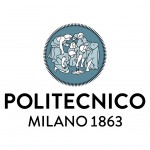Locations

Venue Politecnico di Milano
 The Polytechnic University of Milan (Italian: Politecnico di Milano) is the largest technical university in Italy, with about 40,000 students. It offers undergraduate, graduate and higher education courses in engineering, architecture and design. Founded in 1863, it is the oldest university in Milan.
The Polytechnic University of Milan (Italian: Politecnico di Milano) is the largest technical university in Italy, with about 40,000 students. It offers undergraduate, graduate and higher education courses in engineering, architecture and design. Founded in 1863, it is the oldest university in Milan.
The Politecnico has two main campuses in Milan city, where the majority of the research and teaching activity are located, and other satellite campuses in five other cities across Lombardy and Emilia Romagna. The central offices and headquarters are located in the historical campus of Città Studi in Milan, which is also the largest, active since 1927.
The university was ranked the best for Engineering and among the top big universities in Italy in the CENSIS-Repubblica Italian University rankings for 2011-2012 and is ranked as the 28th best technical university in the world according to the QS World University Rankings.
Its notable alumni include Giulio Natta, Nobel laureate in chemistry in 1963.
Milan
Milan (Italian: Milano) is financially the most important city in Italy. It has the second most populous city proper in the country, but sits at the centre of Italy’s largest urban and metropolitan area. While incorrectly not considered as beautiful as some Italian cities, having been partly destroyed by Second World War bomb raids, the city has rebuilt itself into a thriving cosmopolitan business capital. In essence, for a tourist, what makes Milan interesting compared to other places is that the city is truly more about the lifestyle of enjoying worldly pleasures: a paradise for shopping, football, opera, and nightlife. Milan remains the marketplace for Italian fashion – fashion aficionados, supermodels and international paparazzi descend upon the city twice a year for its spring and autumn fairs. Don’t get fooled by the modern aspect of the city, since it’s one of the most ancient cities in Europe with more than 26 centuries of history and heritage!
Milan is famous for its wealth of historical and modern sights – the Duomo, one of the biggest and grandest Gothic cathedrals in the world, La Scala, one of the best established opera houses in the globe, the Galleria Vittorio Emanuele, an ancient and glamorous arcaded shopping gallery, the Brera art gallery, with some of the finest artistic works in Europe, the Pirelli tower, a majestic example of 1960s modernist Italian architecture, the San Siro, a huge and famed stadium, or the Castello Sforzesco, a grand medieval castle and the UNESCO’s World Heritage Site Santa Maria alle Grazie Basilica, containing one of the world’s most famous paintings: Leonardo da Vinci’s The Last Supper. Source: WikiTravel
An interesting article about Milan: Here’s What An Average Day In Milan Looks Like.
Feel free to check WikiTravel for further traveling information. If you have any questions, please don’t hesitate to contact us.
Hotels
Thanks to its popularity as a destination, Milan has a wonderful range of hotels on offer. Be sure to take advantage of the special hotel rates available only to our attendees.
Getting There
By plane
Milan has two main international air gateways, Linate airport and Malpensa airport. Sometimes referred to as Milan’s additional airports, Bergamo’s Orio al Serio airport (45km East) and Parma airport (100km South) mostly host budget airlines.
By train
Central railway station
The main railway station is the Central Station (‘Milano Centrale’)[18], which is served by Trenitalia [19], the State Railways. Regular express and fast trains serve all Italian cities (Turin, Venice, Rome, Naples, Florence and many others), and some European cities (Barcelona, Zurich, Geneva, Munich, Paris, Stuttgart, Zagreb, Vienna, etc.).
